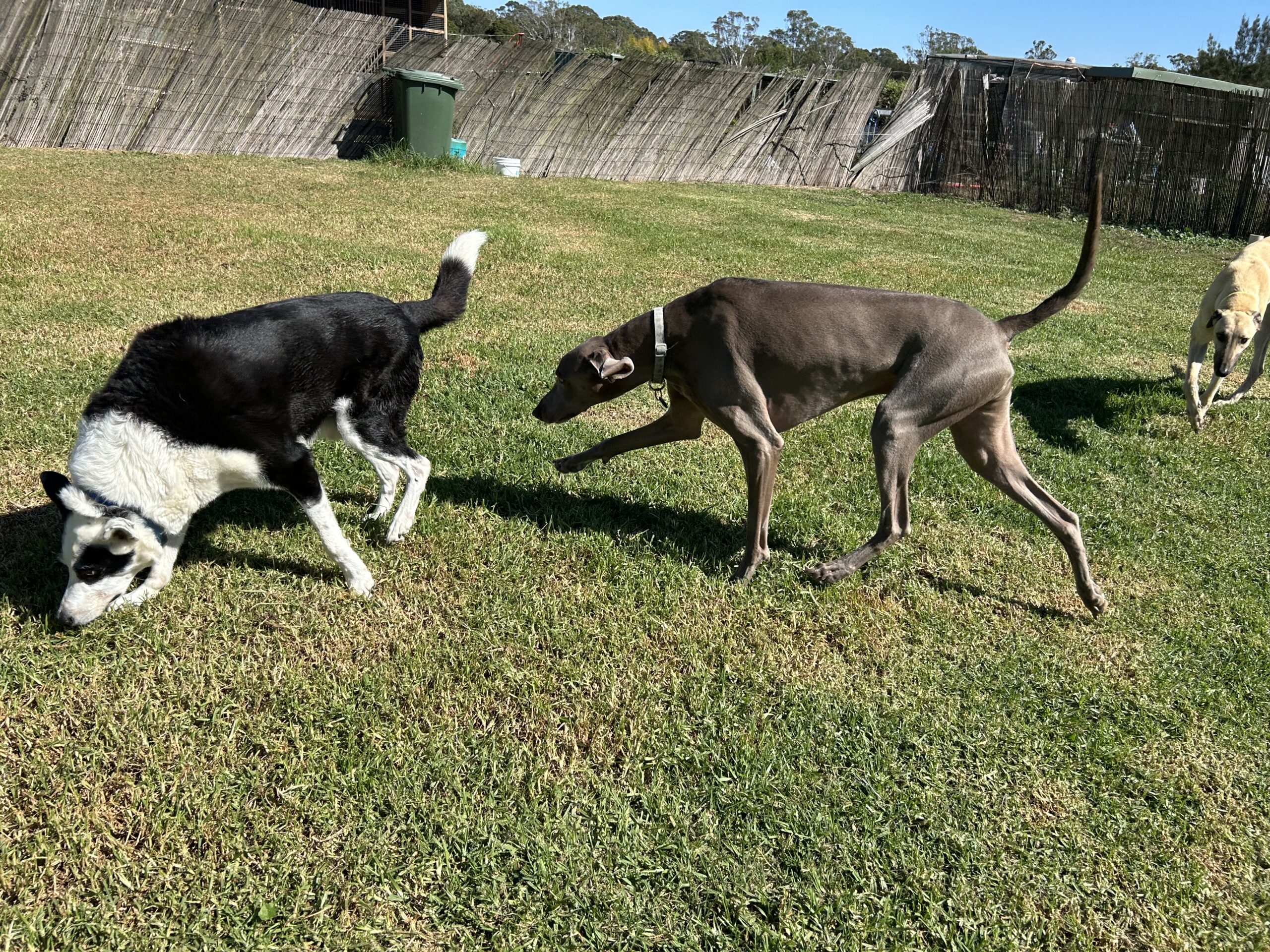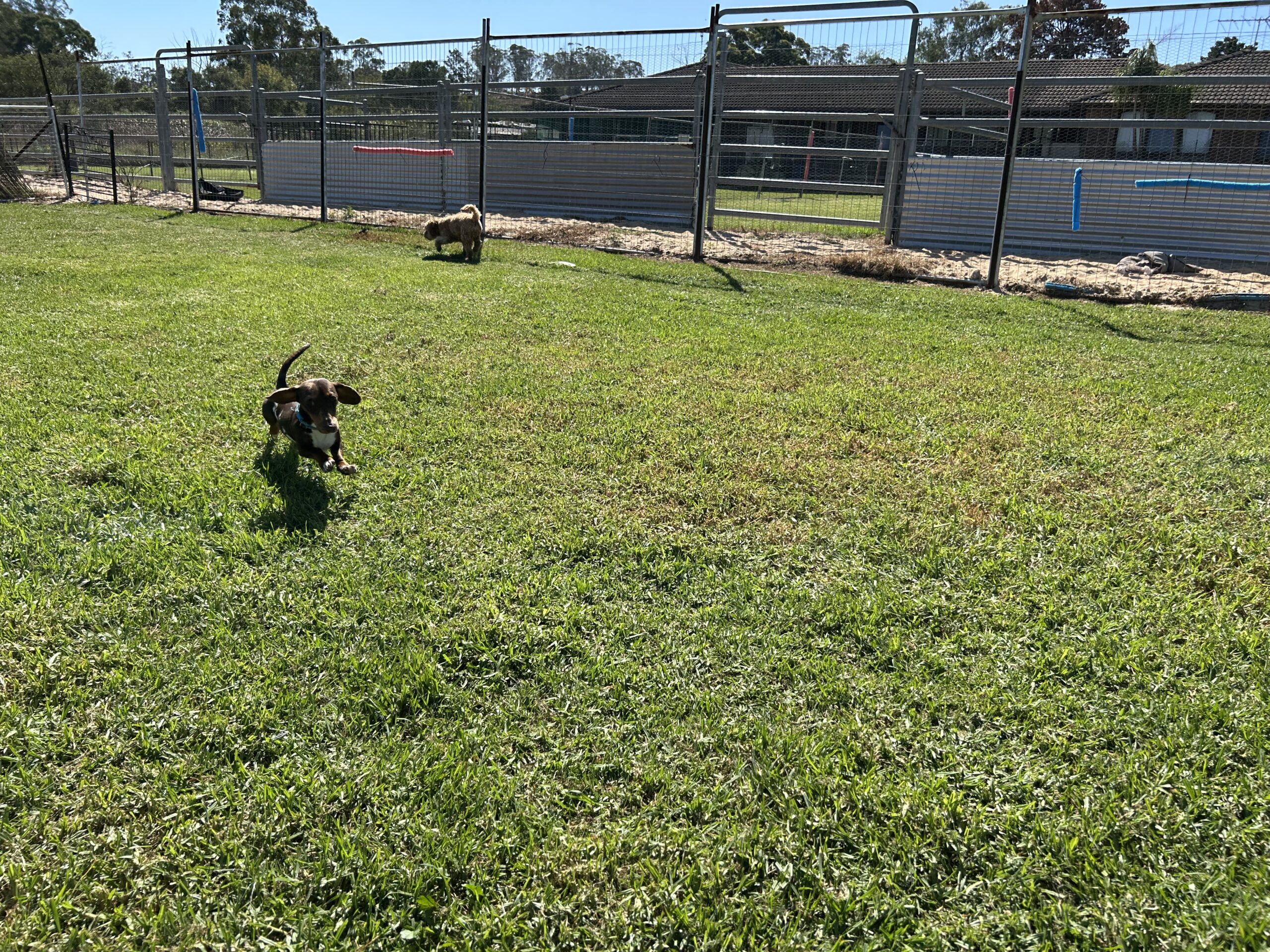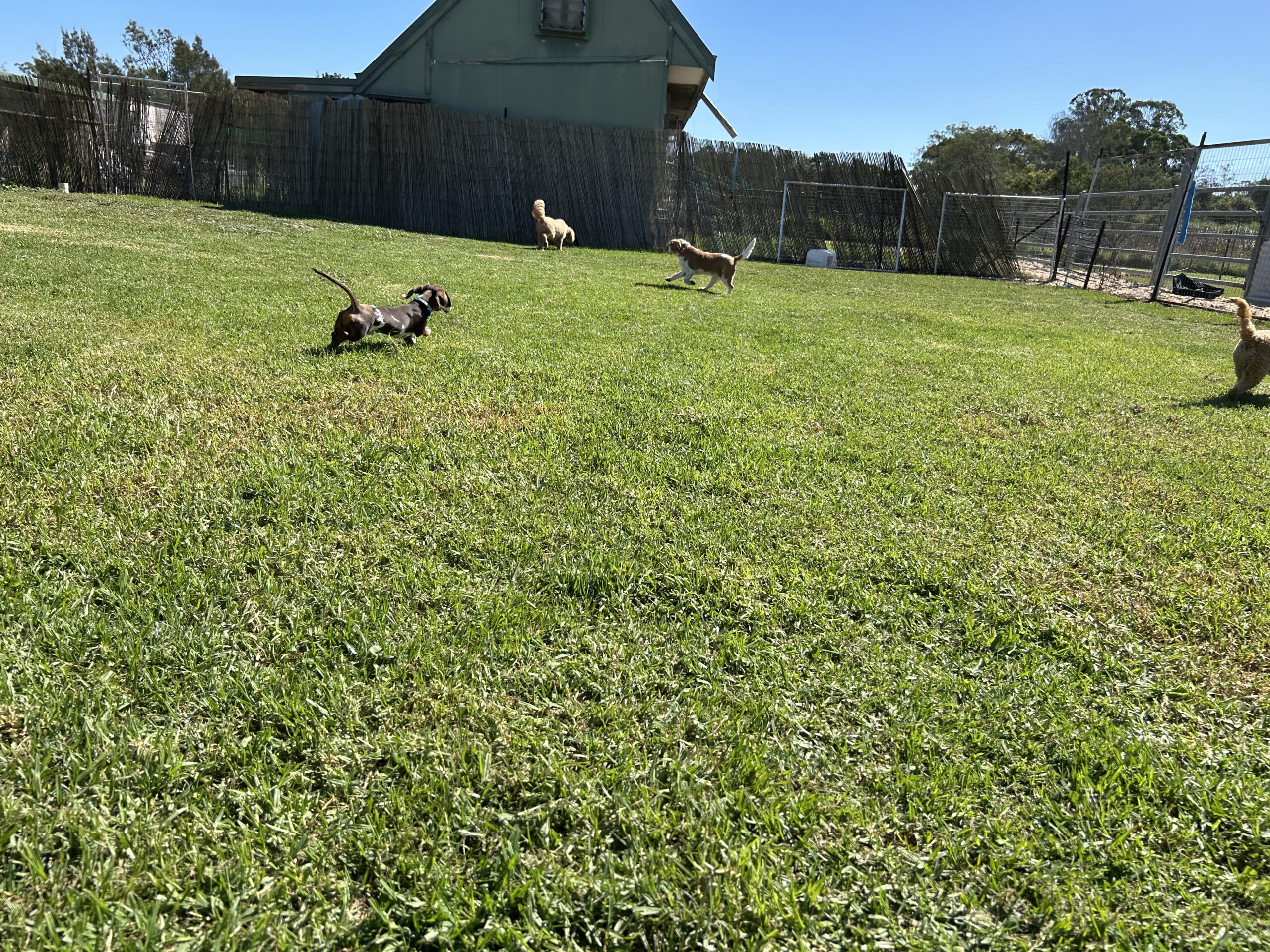Facility Design Essentials: Peaceful Environments for Optimal Canine Experience
Facility design essentials create superior daycare experiences through purpose-built features that support canine physical safety, psychological comfort, and developmental needs beyond basic supervision space.
Key Takeaways: Critical Environmental Design for Quality Care
| Essential Design Features | Why It Matters |
|---|---|
| Facility design essentials include purpose-built spatial organization | Strategic layouts prevent stress and support natural behavior |
| Professional acoustic management prevents noise overstimulation | Sound control reduces stress hormone elevation |
| ️ Temperature regulation systems support physiological comfort | Appropriate climate prevents heat stress and discomfort |
| Non-slip flooring prevents injuries during active play | Surface quality directly impacts physical safety |
| Multiple distinct zones support diverse behavioral needs | Separated areas allow appropriate activity variation |
| Appropriate lighting prevents stress triggers and shadows | Visual environment affects behavioral comfort |
| Indoor-outdoor access provides environmental enrichment | Natural elements support psychological wellbeing |
| Hygienic systems protect health beyond basic cleanliness | Design-integrated sanitation prevents disease transmission |
“The Environmental Impact: Is Your Dog’s Daycare Facility Designed for Canines or Just Converted Space?”
Have you thoroughly assessed the physical environment where your dog spends significant time, or simply confirmed it appears generally clean and adequate? Many devoted owners overlook the profound impact facility design has on their dog’s experience, failing to distinguish between purpose-built environments and merely converted spaces—a distinction that fundamentally affects physical safety, stress levels, and overall wellbeing.
Research from veterinary environmental science reveals that facility features dramatically influence canine psychological and physical health, with purpose-built design elements significantly reducing stress indicators and injury rates. Even more concerning, a comprehensive study from the University of Melbourne found that dogs in converted facilities without canine-specific design showed 83% higher cortisol levels and substantially elevated behavioral stress indicators compared to those in purpose-built environments.
The implications extend beyond comfort to fundamental wellbeing and safety concerns. According to certified facility design specialists, seemingly minor elements like flooring type, acoustic properties, and spatial organization create dramatically different physiological responses in dogs—effects that accumulate during regular attendance. The good news? Understanding facility design essentials allows you to evaluate environments based on evidence-based criteria rather than superficial appearance.
Facility Design Essentials Through Purposeful Architecture
Facility design essentials operate on a fundamental principle: canine environments require specific features supporting species-appropriate needs rather than merely converted human spaces. Unlike adapted buildings, quality facility design essentials implement sophisticated architectural elements designed by canine environmental specialists.
“Most owners dramatically underestimate the importance of purpose-built environments,” explains Dr. Emma Richardson, veterinary behaviorist specializing in environmental impacts. “Converted spaces often appear adequate but lack critical design elements that support canine wellbeing. Effective facility design essentials incorporate specific features addressing physiological and psychological needs rather than simply providing basic containment space.”
Premier facilities implementing comprehensive facility design essentials demonstrate excellence through:
Strategic Spatial Organization
Purpose-built layout creating appropriate zone separation—providing critical activity distinctions through thoughtful design:
- Distinct play areas separated from quiet spaces
- Strategic sight line management preventing overarousal
- Appropriate spatial proportions supporting natural movement
- Activity zones designed for specific purposes
- Transition areas buffering between different spaces
- Decompression zones allowing regulated withdrawal
- Size-appropriate areas preventing crowding stress
- Traffic flow designed to minimize congestion points
Sophisticated Acoustic Management
Professional sound control systems preventing stress-inducing noise—creating appropriate auditory environments beyond basic soundproofing:
- Acoustic panel installation absorbing echo and reverberation
- Strategic material selection reducing sound amplification
- Zone separation preventing noise transfer between areas
- Sound dampening barriers in high-activity spaces
- Barking management through design solutions
- Background sound systems masking startling noises
- Strategic equipment placement minimizing noise impact
- Outdoor sound barriers reducing external triggers
Comprehensive Surface Engineering
Specialized flooring systems supporting physical safety—providing appropriate traction and impact absorption:
- Commercial-grade non-slip surfaces throughout activity areas
- Impact-absorbing materials preventing joint stress
- Seamless transitions between different flooring types
- Appropriate substrate selection for specific activities
- Temperature-neutral materials preventing heat transfer
- Easily sanitizable surfaces supporting hygienic maintenance
- Outdoor surface design preventing mud and debris tracking
- Varying textures providing sensory enrichment
“These facility design essentials create fundamental improvements in canine experience,” notes environmental design specialist Dr. James Wilson. “In quality purpose-built facilities, we’re not simply providing space but creating environments specifically engineered to support canine wellbeing through evidence-based design elements.”
Is Your Dog’s Daycare Environment Truly Purpose-Built? Take This Assessment:
- Does the facility feature purpose-designed acoustic management beyond basic construction?
- Are multiple distinct zones available with appropriate separation between activities?
- Does flooring consist of commercial-grade materials specifically selected for canine safety?
- Are climate control systems designed for canine comfort rather than human preferences?
- Does spatial organization demonstrate clear purpose beyond simple room conversion?
If you answered “no” to two or more questions, your dog’s facility may represent converted space rather than purpose-built design—precisely the environmental limitation that comprehensive facility design essentials address through specialized architecture.
Specialized Environmental Features for Superior Daycare Facilities
Premier facilities implementing facility design essentials incorporate sophisticated environmental elements creating exceptional canine experiences. These aren’t simple conversions but comprehensive architectural systems designed by canine specialists.
“The difference between converted space and purpose-built environments is profound,” explains Dr. Sarah Williams, canine environmental psychologist. “Proper facility design essentials systematically address specific canine needs through architectural features that support fundamental wellbeing beyond basic space provision.”
Leading facilities incorporating comprehensive facility design essentials feature specialized elements such as:
Climate Optimization Systems
Advanced temperature and humidity control designed specifically for canine comfort—providing appropriate environmental conditions beyond basic heating and cooling:
- Specialized HVAC systems designed for canine temperature preferences
- Strategic air exchange preventing respiratory irritation
- Zoned climate control accommodating different activity levels
- Appropriate humidity management preventing respiratory stress
- Heat-regulation materials in high-activity areas
- Temperature monitoring systems ensuring consistent comfort
- Seasonal adaptability accommodating changing conditions
- Appropriate ventilation preventing odor accumulation
Illumination Engineering
Purpose-designed lighting systems supporting visual comfort—creating appropriate visual environments preventing stress triggers:
- Natural light integration without glare or harsh exposure
- Strategic artificial lighting preventing shadow-casting
- Appropriate brightness levels for canine visual comfort
- Transitional lighting preventing startle responses
- Circadian-supportive systems maintaining natural rhythms
- Glare elimination preventing visual stress
- Shadow reduction minimizing startle triggers
- Evening lighting transitions supporting relaxation
Hygienic Architecture Integration
Design-integrated sanitation systems supporting health beyond basic cleaning—preventing disease transmission through built-in features:
- Seamless surface transitions eliminating collection points
- Material selection supporting thorough sanitization
- Drainage systems integrated into structural design
- Air purification preventing respiratory pathogen transmission
- Strategic waste management designed into facility layout
- Cross-contamination prevention through zone separation
- Foot bath integration at critical transition points
- Sanitation station strategic placement throughout facility
Case Study: The Environmental Impact on Canine Experience
Facility A (Converted Space): Initially appealing due to cleanliness and general adequacy, deeper evaluation revealed significant design limitations affecting canine experience:
- Converted warehouse with basic room partitions
- Standard commercial flooring lacking appropriate traction
- Minimal acoustic management creating noise amplification
- Basic HVAC system designed for human preferences
- Limited zone separation with minimal activity differentiation
- Standard lighting with significant shadow-casting
- Improvised sanitation systems without design integration
- Limited outdoor access through basic door systems
Facility B (Purpose-Built Environment): Demonstrated comprehensive facility design essentials across all domains:
- Architect-designed facility specifically for canine needs
- Commercial-grade K9 flooring with appropriate traction and impact absorption
- Comprehensive acoustic engineering with sound absorption panels
- Canine-specific HVAC system with activity-based zoning
- Multiple distinct areas with appropriate separation and transition zones
- Specialized lighting eliminating shadows and stress triggers
- Design-integrated sanitation systems supporting thorough disinfection
- Purpose-built indoor-outdoor transition with appropriate access control
Observable Difference in Canine Response: “The contrast in dog behavior between facilities was immediately apparent,” reports certified behaviorist Dr. Jennifer Chen following controlled observation. “Dogs in Facility A showed significantly elevated stress indicators including increased panting, pacing, and startle responses. The same dogs in Facility B demonstrated noticeably reduced arousal, improved relaxation capacity, and more appropriate social interaction. The facility design essentials difference created dramatically different physiological and behavioral responses despite similar care protocols.”
Design Quality Indicators Visible During Facility Evaluation
Not all design elements require professional knowledge to identify. During your evaluation of facility design essentials, observe these accessible indicators of purpose-built quality:
Activity Zone Differentiation
Quality facilities demonstrate clear separation between different functional areas:
- Distinct play areas separate from quiet spaces
- Appropriate barriers creating meaningful separation
- Multiple activity zones serving different purposes
- Strategic organization preventing cross-activity disruption
- Size-appropriate areas preventing crowding
- Transition spaces between different activity zones
- Decompression areas allowing voluntary withdrawal
- Individual spaces available for personal needs
Flooring System Quality
Superior surfaces show purpose-selection beyond basic function:
- Consistent non-slip properties throughout activity areas
- Absence of hard, slippery surfaces in play zones
- Appropriate transition between different surface types
- Visible resilience absorbing impact during play
- Seamless installation preventing collection points
- Commercial-grade materials rather than residential
- Surface pattern preventing visual stress
- Appropriate traction even when wet
Sound Management Effectiveness
Quality acoustic design becomes evident through noise experience:
- Minimal echo or reverberation during active play
- Voice clarity without shouting requirement
- Reduced sound transfer between different areas
- Appropriate background noise masking startling sounds
- Absence of noise amplification during excited barking
- Conversation possibility without elevated volume
- External noise buffering from traffic or other triggers
- Normal play sounds without overwhelming volume
Design Quality Comparison: Converted Space vs. Purpose-Built Environment
| Design Element | Converted Space Characteristics | Facility Design Essentials Benefits |
|---|---|---|
| Spatial organization | Typically adapted rooms with limited purpose | Strategic layout designed specifically for canine needs |
| Flooring systems | Often commercial or residential general-purpose | Specialized surfaces supporting safety and cleanliness |
| Acoustic management | Minimal modification beyond basic construction | Comprehensive sound engineering preventing stress |
| Climate control | Standard HVAC designed for human comfort | Canine-specific systems accommodating activity levels |
| Lighting design | Basic illumination without specific consideration | Purpose-engineered systems preventing stress triggers |
| Zone separation | Limited division using available structure | Multiple distinct areas supporting various needs |
| Sanitation integration | Added systems without architectural incorporation | Design-integrated features supporting thorough hygiene |
| Outdoor access | Basic door systems with limited transition | Purpose-built indoor-outdoor flow with appropriate controls |
Long-Term Benefits of Purpose-Built Environmental Design
Facility design essentials focused on canine-specific architecture offer enduring advantages that fundamentally impact wellbeing. Recent analysis from the University of Queensland’s Veterinary Environmental Science Department revealed that dogs attending purpose-built facilities showed significantly lower stress indicators, improved behavioral stability, and substantially reduced injury rates compared to those in converted environments despite identical care protocols.
“We now understand that environmental design creates profound physiological impacts beyond simple preference,” explains environmental design specialist Dr. Robert Thompson. “The purpose-built features incorporated through comprehensive facility design essentials fundamentally influence stress hormone levels, immune function, and behavioral stability through their cumulative effects on canine experience.”
Evidence-based benefits of purpose-built environments include:
- Reduced cortisol levels through appropriate stress management
- Decreased injury rates through safety-focused design
- Improved immune function through reduced chronic stress
- Enhanced behavioral stability through environmental comfort
- Better sleep quality through appropriate rest zone design
- Reduced aggressive incidents through strategic space management
- Improved social interaction through appropriate environmental design
- Enhanced overall wellbeing through comprehensive comfort support
These environmental benefits create substantially different physiological responses, making facility design essentials a critical factor in quality evaluation beyond care protocols.
How Different Dog Types Benefit from Specialized Environmental Design
Facility design essentials become even more critical for dogs with specific characteristics or needs. Different dog types particularly benefit from the enhanced environments purpose-built facilities provide:
Noise-Sensitive Breeds
Dogs with acoustic sensitivity require the sophisticated sound management facility design essentials provide—creating appropriate auditory environments that prevent stress responses through proper acoustic engineering.
Movement-Restricted Individuals
Dogs with mobility limitations need the specialized surface systems facility design essentials incorporate—providing appropriate traction preventing injury while supporting comfortable movement through purpose-selected flooring.
Temperature-Sensitive Types
Brachycephalic breeds and dogs with thermal regulation challenges benefit from the climate control facility design essentials implement—creating appropriate environmental conditions through specialized HVAC systems.
Anxiety-Prone Personalities
Dogs with stress tendencies require the comprehensive environmental design facility design essentials deliver—providing appropriate sensory management through purpose-built features addressing potential triggers. For these dogs, consider facilities that offer specialized care for anxious dogs and understand their unique needs.
Environmental Design Evaluation Checklist
When assessing facility quality, use this evidence-based checklist to evaluate design beyond superficial appearance:
- Multiple distinct zones supporting different activities and needs
- Purpose-selected flooring providing appropriate safety and cleanliness
- Acoustic management preventing noise stress and amplification
- Climate control systems designed for canine comfort
- Appropriate lighting preventing stress triggers and shadows
- Design-integrated sanitation supporting thorough hygiene
- Strategic spatial organization preventing crowding and conflict
- Indoor-outdoor access providing environmental enrichment
When evaluating facilities, also consider their daycare safety protocols and how these integrate with the environmental design features.
Critical Questions for Evaluating Facility Design Quality
When investigating potential daycare environments, ask these revealing questions to assess their facility design essentials commitment:
- “Was this facility purpose-built for dogs or converted from another use?”
- “What specific acoustic management features prevent noise stress?”
- “How was flooring selected specifically for canine safety and hygiene?”
- “What distinct zones are available supporting different activities?”
- “How does the climate control system accommodate canine preferences?”
- “What design-integrated sanitation features support thorough hygiene?”
The facility’s ability to provide substantive, detailed responses reveals their true commitment to facility design essentials versus operations in merely adequate converted spaces.
For first-time daycare users, understanding these design elements becomes even more crucial. Learn more about preparing for your first daycare experience and what to expect from quality facilities.
Special Considerations for Different Life Stages
Different life stages require specific environmental considerations that quality facility design essentials address:
Puppy-Specific Design Requirements
Young dogs need environments that support their developmental needs. Quality facilities incorporate puppy daycare requirements into their design, including appropriate play surfaces, smaller-scale equipment, and areas designated for rest and learning.
Senior Dog Environmental Needs
Senior dogs benefit from specialized environmental features including softer flooring surfaces, temperature control for comfort, and quiet zones for rest. Purpose-built facilities design these elements into their architecture rather than retrofitting spaces.
Special Needs Accommodations
Facilities serving dogs with mobility challenges or medical needs require specialized design elements. Learn about special needs dog boarding and how proper facility design supports these requirements through accessible layouts and appropriate accommodations.
Maintenance and Cleanliness Standards
Beyond initial design, ongoing maintenance reflects commitment to environmental quality. Quality facilities implement daycare cleaning standards that work synergistically with their architectural features, ensuring that design-integrated sanitation systems function effectively.
The relationship between facility design and hygiene maintenance is critical for illness prevention. Purpose-built facilities incorporate features that support thorough cleaning and disinfection as part of their architectural design.
Conclusion: Transform Canine Experience Through Environmental Excellence
Facility design essentials create fundamentally different daycare experiences compared to converted spaces providing merely adequate environments. By prioritizing facilities with purpose-built features, you ensure your dog receives care in environments specifically engineered to support their wellbeing rather than simply adapted human spaces.
Each design element contributes to overall environmental quality. The cumulative effect of comprehensive architecture creates exceptional surroundings—transforming daycare from adequate containment to genuinely supportive environment through evidence-based design.
“When we examine the environmental evidence,” notes Dr. Jessica Moore, veterinary behaviorist, “the conclusion is clear: purpose-built design through comprehensive facility design essentials represents one of the most critical factors determining daycare quality, creating substantially different physiological responses through the implementation of canine-specific architecture.”
Your dog deserves environments created specifically for their needs rather than merely adapted spaces. Prioritize facilities implementing comprehensive facility design essentials to ensure your dog experiences the physiological and psychological benefits that purpose-built environments provide.
Understanding these design principles helps you make informed decisions about choosing quality daycare and ensures your dog receives care in environments that truly support their wellbeing.
External Links:
- Canine Boarding Lodge
- Mobile Dog Grooming Services
- Canine Glamour Facebook
- Canine Glamour Instagram
- Canine Glamour TikTok
- Canine Boarding Lodge Facebook
Follow for more: For more grooming tips visit: FB: Canine glamour Instagram: Canine glamour TikTok: Canine Glamour For more boarding tips visit: FB: Canine boarding lodge





